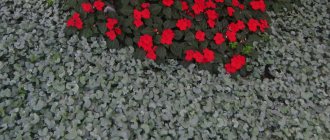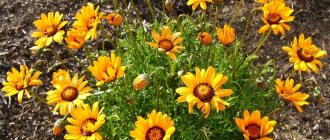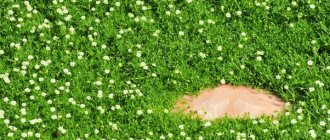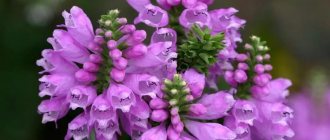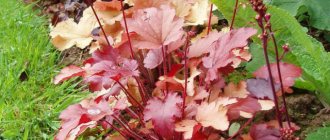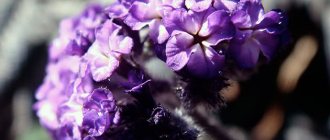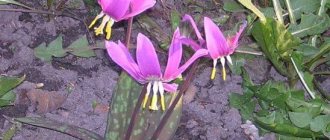Kermek (Limonium): description, photo, planting and care
If you come across a flower with a thick and bright cap of delicate inflorescences, similar to a floating cloud on top of green foliage, then you can say with confidence that this is limonium, which many gardeners dream of with lust.
This colorful beauty has a very original appearance, unlike the other flowers in the flowerbed. Only in recent years has the plant gained enormous popularity among flower growers, and before that only the most experienced specialists knew about it.
We must pay tribute to this amazing plant, since it also has a very flexible character; there are no special complaints or vagaries when growing. Most varieties of kermek are perennials and there is no need to replant the plantings annually.
It should also be noted that limonium, for the most part, is frost-resistant and can easily withstand the winter inconveniences of mid-latitudes.
Kermek owes its unusual name to Turkic roots. But this unusually beautiful plant has many different names. One of them is limonium. This name is Greek and has nothing to do with lemons. Translated from ancient Greek, this word means meadow.
In our country you can also hear the name statice, and in other countries kermek is called “sea lavender” or “swamp rosemary”.
Varieties of limonium have long settled over vast territories: North America, Australia, Africa, Europe. They can even grow on saline seashores. And some species are found even in areas with very harsh climatic conditions, in Altai and Siberia.
Some species growing in steppe and desert areas form tumbleweeds, dispersing seeds to survive and expand their habitat.
The handsome Kermek also has a lot of useful properties, known since ancient times. It produces multi-colored natural dyes used to dye leather and yarn for carpets. Limonium roots contain tannin, which is used in tanning.
Its healing properties are also known. It is used to heal wounds and as a means to stop bleeding. But the most important advantage of kermek is the decoration of gardens.
Botanical description
The genus is quite numerous, numbering more than three hundred species.
Limonium belongs to the lead family. Grows as a herbaceous or shrub plant. There are perennials and biennial species. In its natural habitat it can grow up to two meters in height.
Kermek's roots reach a meter in length, so the plant has adapted to survive in arid areas with a lack of water, extracting it at great depths.
The leaf blades are lanceolate and collected in a rosette around the root, or long and saber-shaped.
The color of the leaf blades is green, less often grayish-green. The stems have a pubescent edge and are somewhat branched at the top. The flowers are shaped like bells. They are small in size, collected in spikelets, which then form panicles or corymbose inflorescences.
In mid-latitudes, limonium begins to bloom from July until the onset of frost. In warmer climates, kermek blooms much earlier.
The colors of the inflorescences are very diverse. You can find white, different shades of purple, pink, purple, green, yellow. Many species are grown not only as an ornamental plant, but also as an excellent honey plant.
Perennial:
Broad-leaved or flat-leaved - Limonium platyphyllum
It received this name because of its wide, leathery leaves of a rich, green color. This is a herbaceous, pubescent plant, medium tall, reaching 60-70 centimeters in height.
The flower stalks that grow from the center of the rosette do not have leaves. Small, lilac-violet flowers, on branched shoots, are presented in the form of corymbose inflorescences.
It begins to bloom in July and continues until mid-September. During flowering, flat-leaved kermek presents a colorful sight. It looks like a large ball woven from thin lace, up to half a meter in diameter.
Kermek broadleaf, having come from the wild, has remained virtually unchanged in home gardens. In its natural environment it grows in steppe conditions. Although no one specifically bred them, this species is so frost-resistant and just as decorative that it remains one of the most popular.
Growing naturally in steppe and arid areas, limonium broadleaf requires the same conditions in the garden. Sunny and open places are best suited for it.
Gmelina - Limonium gmelinii
This species is most often used as a medicinal plant. As a decorative flower, Gmelin's kermek is less common than the flat-leaved one. This flower reaches half a meter in height, has a widely branched stem and bluish-green leaves collected in a basal rosette.
The flower stalks are not as lush as those of its broadleaf relative, but are collected in dense, lilac-colored clusters, with a large number of small flowers.
In nature, it lives on salty soils on seashores. Its natural habitat is the steppe regions of Siberia, Mongolia and Northern China. In colder areas, the plant requires shelter from the winter cold, and with the arrival of spring, shading from bright sunlight.
Common - Limonium vulgare
This perennial has large basal leaves and very small purple flowers in the panicles of the inflorescences. It reaches half a meter in height.
The stems of this species are straight and bare, the roots are taproots, reaching up to one meter in length. The leaf plates have an oval shape, assembled in a rosette.
Tatar
Kermek Tatarian grows in the southern part of European Russia, the Caucasus and Ukraine, as well as in Bulgaria. It has wide leaf blades with a leathery structure. This is a low plant, up to 40 centimeters high. In the steppes it grows like tumbleweed.
This species is unpretentious, can grow well on dry and rocky soils, and adapts to both chalky and acidic soils.
When flowering, it forms a very lush spherical bush. It blooms in June, with spreading peduncles and small white flowers.
This kermek is an ideal decoration for a sunny alpine slide and is often used as a dried flower.
Caspian - Limonium caspium
It is a heat-loving species and grows in salt marshes. Grows up to 70 centimeters in height. Peduncles have tiny and highly branched shoots that resemble leaves.
The flowers are small, pale purple. It is not suitable for growing in open ground in the middle zone; it does not tolerate winter temperature drops.
In the southern regions it is often grown as a dried flower because it does not lose color after drying.
Types and varieties of Kermek
All types and varieties of limonium grown in Russia as ornamental crops can be divided into two groups:
- perennial,
- annuals.
Perennials include:
Kermek broad-leaved or flat-leaved (lat. Limonium platyphyllum). A herbaceous, densely pubescent plant, the maximum height of which is 60-70 cm. Large, rich green leaves are collected in a dense basal rosette. There are no leaves on the peduncles growing from the center of the rosette. Small lilac flowers are collected in numerous corymbose inflorescences. At the height of flowering, broadleaf limonium looks very impressive and resembles a large lace ball. The following varieties can be noted:
- “Violetta” (Violetta) is a medium-sized (about 60 cm) plant with strongly branching shoots and lavender-colored inflorescences.
- "Robert Butler" (Robert Butler) - distinguished by the rich lilac tone of the flowers.
- "Grandiflorum" (Large-flowered) - a variety with large inflorescences.
- "True Blue" - dense blue-violet inflorescences.
- “Blue Cloud” is a fairly large variety with spreading stems, the ends of which are decorated with purple flowers.
K. “Violetta”, K. “Robert Butler”, K. “Blue Cloud”
Kermek Gmelin (lat. Limonium gmelinii). A species used primarily as a medicinal plant. In decorative floriculture, Gmelin's limonium, although common, is less common than broadleaf. This is a medium-tall (up to 50 cm) plant with a branched stem, a basal rosette of bluish-green leaves and corymbose inflorescences consisting of a large number of small flowers.
Common Kermek (lat. Limonium vulgare). Herbaceous perennial with large basal leaves and very small purple flowers in paniculate inflorescences.
Kermek Caspian (lat. Limonium caspium). A plant with graceful peduncles decorated with soft lilac flowers. Not very common, because It is not frost-resistant and is suitable for cultivation only in the southern regions.
K. Gmelina, K. ordinary, K. Caspian
There are approximately the same number of species grown in Russia as annuals:
Kermek notched or dark blue limonium (lat. Limonium sinuatum). A perennial plant about 60 cm high with soft green pinnate leaves in a basal rosette and tall erect shoots, at the end of which corymbose inflorescences are formed. Dense shields consist of a large number of small flowers, collected in spikelets and painted in a variety of colors: white, yellow, pink, purple.
Today, many varieties have been bred, differing mainly in the shades of the inflorescences, and both multi-colored and monochromatic mixtures are available for sale:
- “Forever mix” (Consistency, mixture) - a mixture of bright, differently colored varieties.
- “Forever Gold” is a long-blooming (July-September) annual with bright yellow inflorescences.
- "Ice Berg" (Iceberg) - beautiful snow-white flowers.
- “Petite Bouquet” (Petite bouquet) is a colorful mix of low-growing (up to 30 cm) varieties.
K. “Forever mix”, K. “Forever Gold”, K. “Ice Berg”
- "Midnight Blue" - dense inflorescences of a lavender hue.
- “American Beauty” (American beautiful) - the flowers have a very pleasant burgundy-pink color.
- “Nachtblau” (Dark Blue) – as the name implies, the petals are colored deep blue.
K. “Midnight Blue”, K. “American Beauty”, K. “Nachtblau”
Only a few of the most popular varieties are listed here. In fact, there are many more of them and more and more appear every year.
Chinese Kermek (lat. Limonium sinensis). A species that recently became widespread as a decorative species and has gained popularity in a short time. Its distinctive features: large glossy leaves collected in a rosette, from the center of which smooth shoots with inflorescences of yellow, white or cream color appear. The height of the cultivated plant does not exceed 70 cm.
Kermek Perez (lat. Limonium perezii). An exotic, rare species, native to the Canary Islands. Its main difference is large bright inflorescences and thickened oval leaves in a basal rosette. The color of the flowers is all shades of blue or lilac. It blooms only in hot, long summers, so it is better suited for the southern regions.
K. Chinese, K. Perez
Decorative use of kermek
It’s not for nothing that flower growers and designers love Kermek so much. It looks great both in a group with other species, and individually, like a tapeworm. The colorful inflorescences look like fluffy clouds lying on a soft green pillow. The plant can be used to decorate a variety of compositions: rock gardens, rockeries, mixborders. It is not forbidden to place low-growing varieties along paths or paths, forming peculiar flower borders.
[!] Some types of limonium have bright calyxes that decorate the plant after flowering has ended. They are called “eternal flowers”.
Perennials that contrast in color should be selected as partners for Kermek. For blue, pink and purple varieties - yellow and orange marigolds and calendula, for white and yellow - pink armeria or pyrethrum.
Medium-tall and tall species will look good with lower flowering ground covers: saxifrage, arabis, helianthemum.
[!] Kermek broadleaf should not be planted near the house, veranda or gazebo: the flowers of this species have a sharp, unpleasant odor. Dried broadleaf limonium flowers have no aroma.
Limonium is often harvested for drying. The fact is that dried flowers do not lose their brightness and retain their color for a long time. Kermek for dried flowers should be prepared only in dry, warm weather, giving preference to blue and yellow varieties that almost do not fade in the sun.
This beautifully flowering perennial is often used as a cut flower. Delicate airy inflorescences perfectly set off the larger and brighter flowers of other plants.
Growing and care
When growing Kermek, the main condition will be to find a bright, sunny place for planting. This is perhaps the main condition for growing. Without enough light, its stems will begin to stretch and thin, and flowers will not be able to form at all.
But the composition of the soil for limonium does not matter much. But it is better not to plant it on too heavy clay soils. The best option would be to choose loose soil with good drainage, to which sand has been added.
In dry weather, kermek is watered moderately; this steppe plant calmly tolerates a lack of moisture. But if the leaves are dehydrated and wither, then watering is still necessary.
Feeding is also simple. Complex fertilizers are applied only once, during planting; Kermek does not require more. But if limonium is grown to obtain a lush bouquet, then fertilizing is done twice a month, and the soil around the bush is also mulched and loosened.
Kermek, cultivation and care, video:
Flowering of perennial species begins in the second or even third year after planting, after the formation of a powerful root system.
Almost all species tolerate wintering normally in mid-latitude conditions without shelter. Kermek suffers only from spring floods, since this beauty does not tolerate waterlogging of the soil.
General characteristics of limonium
This crop grows in the form of a subshrub; it also occurs in the form of a herbaceous perennial. The leaves of limonium are quite large, often located close to the root system and grouped into a large rosette. The stems have dense pubescence, the height of the shoots varies from thirty centimeters to ninety. The stems grow straight, there is no foliage. The flowers are quite miniature and are part of the spikelets. The spikelets, in turn, are grouped into inflorescences, which, as a rule, resemble a panicle in shape. The flowers themselves can have a wide variety of colors. Flowering of statice occurs in July and lasts until frost occurs. Limonium seeds remain viable for four to five years.
This is not a very demanding crop to care for; in some ways it can even resemble a weed. At the same time, this plant is very popular among gardeners not only for this reason. Limonium is almost never attacked by various harmful insects and diseases. In addition, limonium has a high degree of resistance to not the best growing conditions; the plant can easily tolerate dry weather and water shortages.
Limonium shows good results in almost any soil; it requires almost no maintenance. If you don’t have time, then fertilizing is not at all necessary.
However, there are some factors that can negatively affect the growth and development of the plant. These include excessive waterlogging of the root system. Water should under no circumstances stagnate in the soil. In addition, limonium cannot be planted in strong shade; the lack of sunlight will also have a bad effect on your plantings. This plant is quite demanding of heat, so sub-zero temperatures are not acceptable. For this reason, in our winter conditions, limonium is usually grown as an annual plant.
Description of the Kermek plant
The perennial kermek can reach 30-100 cm in height. It prefers open and sunny areas. The flowers can be white, purple, blue, pink or greenish.
Photo of Kermek plant
Kermek belongs to the Plumbaginaceae family.
Kermek owes its name to the Turkic people. This plant also has a second Greek name, limonium, the translation of which means “meadow”.
Among the people, this plant - dead wood - is called "tumbleweed".
The popular name is justified, because wild species of limonium can indeed often be seen moving in the steppes in the fall, driven by the wind.
Brief overview of Kermek - video
The root system is taproot type.
The root is capable of going deep into the ground at distances of up to 90 cm. This feature allows the plant to survive long periods of drought.
Limonium stems are branched and erect in the upper part with slight drooping. In general, the plant has a spherical shape. Belonging to a species is determined by the structure of the foliage. Leaf blades can be wrinkled, pinnate or entire. It happens that the foliage is collected in basal rosettes or, on the contrary, huddles on shoots branched in the upper part.
Limonium flowers are small but numerous. They are five-membered, funnel-shaped or bell-shaped. Flowers are collected in spikes or baskets. The corolla is larger than the calyx. The petals of the flower are connected at the very base.
The flowering period is quite long - it can begin in early summer and last until the onset of frost.
General description of perennial
Kermek Tatarian is a perennial herb, less often a subshrub. Large, elongated, lanceolate-shaped leaves are located in the basal region. Dense, leathery, with a glossy sheen. They have a green, bright light green or grayish emerald color. The stems are thin, flexible, branched, green, and usually do not exceed 50 cm in height. The shape of the bush is spherical.
Kermek Tatarian blooms in early summer. Inflorescence panicles are located at the ends of the shoots. The flowers are small, five-petaled, bell-shaped, with thread-like stigmas. The color is light pink, white, cream, rich cornflower blue, light lavender. Many varieties combine buds of two colors on one inflorescence, for example, white and blue.
Attention! Kermek Tatar has powerful roots that penetrate deep into the ground, which makes replanting an adult plant without damaging the rhizome impossible.
Varieties of Kermek
About 300 types of Kermek are used in floriculture. In nature, the plant is found in North Africa, the Mediterranean, and Australia. Limonium can grow without problems in arid climates. Kermek can be grown as an annual, biennial and perennial.
About 30 plant species are grown in culture.
Thanks to renewed interest in the plant, many breeders are producing new varieties, to the delight of gardeners.
Useful properties and uses of Kermek - video
The following types of cermek are in stable demand:
Boduelli, Chinese kermek and notched species are grown as annual plants.
Perennial plants include Gmelin's kermek, common, Caspian and broadleaf.
Kermek Gelina
Kermek Gelina can be found in the wild in the vastness of Siberia, Central Asia, Mongolia and Northern China.
It prefers to grow in river valleys and sea coastal areas.
Photo by Kermek Gelina
This type of plant is very similar to broadleaf kermek.
The foliage of the plant is ovoid in shape, the color is close to bluish-green. Purple paniculate peduncles. Sometimes there is Glelin's kermek with white flowers. The time for flowering occurs at the end of the summer season.
The plant looks great when dried, is a honey plant and can be used as a natural dye for fabrics and leather. Kermek Gelina is drought- and frost-resistant. Has no other varieties.
Kermek Caspian
Kermek Caspian is found in the same places as the Glelin variety. The plant is a perennial, preferring seashores and salt marshes. Shoots grow along the entire trunk. The inflorescences are small and lilac in color. Kermek Caspian is endowed with high decorative qualities and is actively grown, especially in the west.
Photo Kermek Caspian
Common Kermek
The plant is native to the countries of Africa and Western Europe.
The height of the kermek is about half a meter. The stems have large foliage and small purple flowers. Inflorescences are collected in spikelets. The flowering time takes 50 days.
Photo of ordinary Kermek
Kermek broadleaf
In the wild, the plant is found in the Caucasus or in European countries along forest-steppes.
The height of broadleaf kermek can reach 80 cm. The foliage has an edge and an ellipse shape on the shoots at the root. The leaf blades are large, green, forming a rosette. At the end of summer, shoots appear from the rosette, devoid of foliage, which are crowned with blue or purple inflorescences. At the time of flowering, the broadleaf kermek forms a beautiful sight. The bush resembles a beautiful openwork flowering ball.
Photo Kermek broadleaf
In cultivation, the plant prefers permeable soils and sunny areas. Kermek can be propagated using seeds. Seedlings are planted in a permanent location at the end of summer. Adult plants do not tolerate transplantation well.
If there is an urgent need, you can try to propagate the plant vegetatively or by root division. But in this case the failure rate is high. Domestic flower growers grow broad-leaved species without organizing shelter for the winter. Stagnation of moisture is harmful to the plant.
Reproduction of Kermek by seeds, using seedlings
It is best to grow Kermek by seed through seedlings.
It is possible to sow limonium seeds in open ground, but small seeds will rarely sprout.
Photo of Kermek seeds
There are more chances when growing Kermek using the seedling method.
The long tap-shaped root of the plant is difficult to remove from the soil without damage. It is this circumstance that explains the rare attempts by gardeners to propagate this representative of the flora using root division.
Kermek seeds are sown in special containers and kept at a temperature not lower than +20C. There should be sufficient lighting and then sprouts will appear 14 days after sowing. Limonium seedlings are cared for traditionally - moistened, ventilated and hardened before transplanting.
Kermek seedlings are planted in a flowerbed maintaining a distance of 20-25 cm. The appropriate time for these procedures is the end of May.
Photo of Kermek shoots from seeds
When planting limonium, you should avoid deepening the root rosette.
The plant belongs to a pleasant group of unpretentious flowerbed residents. Among the large army of pests, only aphids can encroach on limonium foliage.
You can get rid of this insect using special preparations:
With excessive amounts of natural precipitation or watering, the root system of Kermek may suffer from rot.
The organization of a drainage layer and the normalization of the irrigation regime will help prevent this condition.
Transplantation and propagation
Statica is a perennial plant, but in central Russia most varieties are grown as annuals. Perennial species include: Kermek Gmelina, Kermek Caspian, Kermek broadleaf and Kermek ordinary. Annual species often found in gardens are Kermek Bonduelli, Kermek Chinese and notched. There are several methods of propagation: sowing seeds in open ground, seedlings and vegetative methods.
Growing Kermek
The germination rate of the seeds is low, about 20-30%, and the plant does not like transplants. Sow seeds in open ground in early spring, when the possibility of night frosts has passed and the ground has warmed up well. A more effective way to grow Kermek from seeds to seedlings in early March. Each sprouted seed is initially planted in a separate pot, from which it is later transplanted to a permanent place.
Propagation of plants for the garden and vegetable garden
In the garden, the plant reproduces poorly by seeds; most often the seeds do not have time to ripen. Vegetative propagation is also fraught with difficulties, since the root system is very long and it is almost impossible to divide the mother rosette without damaging it. It is better to plant shoots in early spring or autumn.
Bouquets made of kermek
Kermek is often used as a raw material when creating dry bouquets, which can retain their decorative effect for several years.
Photos of bouquets from Kermek
For those who intend to create a bouquet with their own hands, the kermek will need to be cut off immediately after the buds open. The branch is hung in a well-ventilated room and the final moment of drying of the stems is waited.
It has been noted that dry flowers do not fall off and do not lose their color.
Even if you have no intention of cutting the plant, it will serve perfectly as a garden decoration in its usual form. It is only important to remember that Kermek is dependent on sunlight.
Pleasant neighbors for limonium will be marigolds, calendula, rudbeckia, aster of any color, gravilate, sage, etc.
Dried flowers. Limonium, statice, immortelle. Making bouquets - video
Kermek or limonium: organizing plant care
In order for Kermek to grow well on the site, it is provided with high-quality natural light. Otherwise, the shoots will stretch out, the foliage will become faded, and the plant will lose its decorative effect. Kermek does not impose any special requirements on the composition of the soil.
Photo of limonium
The plant does not need frequent watering.
It is necessary to moisten the Kermek only occasionally, when signs of dehydration of the foliage are visible.
The limonium flower also does not need fertilizers.
You can improve the soil composition immediately before planting.
It is also not worth organizing a special wintering for limonium.
At the end of autumn, the above-ground part is cut off and the root part of the plant is covered with dry leaves.
Statica, Kermek, limonium planting care. Growing statice from seeds - video
Limonium - planting and caring for a flower
In the Svinchatkov family there is the Kermek genus. Most of its species are very decorative and are actively used to decorate the garden landscape. One of the representatives is the hero of our article. But contrary to the name, it has nothing in common with lemon.
Content:
In height, depending on the variety, it reaches from 25 to 100 cm. The perennial garden plant tolerates winter well. Bell-shaped flowers of various shades: green, white, beige, blue, purple, yellow, orange. They delight owners with their appearance from early summer to mid-autumn. The representative of the flora has pinnate leaves, their appearance is wrinkled and deformed.
Outdoor care
Location and lighting
Ultraviolet light is very important for growth and full development . Under natural conditions, the bush grows in the steppe. Dependence on the rays of the sun forces gardeners to select open areas. Otherwise, the green shoots stretch out and lose their decorative effect. Over time, they become thinner and flowering stops.
Even a small shadow can cause harm.
Temperature, humidity and watering
The root system of limonium is about 100 cm long. Thanks to this, it tolerates short-term drought well . But prolonged exposure has a negative impact on garden plantings. An alarm signal is drooping and withering leaves. This means that kermek requires “drinking”. Rainwater at room temperature is suitable. The best time to “drink” is in the evening, after sunset. The liquid is poured under the root. Adult representatives need it less than young ones.
Adapts perfectly to our climatic conditions. Why is it so valued by gardeners? The plant prefers dry and hot air. Frosts down to -5 do not pose a danger to it.
Soil and fertilizing
There are no special requirements. But it is absolutely worth excluding heavy clayey ones.
Loose soil with added sand and good drainage is ideal.
If only sandy soil is available, then timely application of fertilizers will make it favorable. Avoid wet and swampy areas when planting. Optimal acidity is neutral or alkaline. Too acidic soil is neutralized with lime . If you want compact bushes, then poor soil will be suitable. Fertile leads to strong branching and growth. Sand can be used as drainage.
For lush and long-lasting flowering, mineral complexes for flowering crops are added. They are added from March to November if the soil is not nutritious. The approximate schedule is once a month. But, if the composition of the soil includes the content of all the necessary elements and minerals, then fertilizing is applied only at planting.
Flowering and wintering
Many owners complain about the lack of “bells”. For their appearance, favorable conditions are necessary: an open sunny landing site; neutral or alkaline loose soil; long and warm summers; the absence of nearby tall neighbors or buildings shading the plant. Perennial species delight with their flowering 1-2 years after planting. This time is required to form a long root system.
If the variety does not tolerate low temperatures, then in the fall it is removed and the flower bed is dug up. Representatives that can survive the cold winter require additional training. It consists of pruning the above-ground part after dying and covering it with foliage. A film is placed on top of the natural material; it will help protect the root system from melt water in the spring.
Use in landscape design
To decorate a garden plot, modern specialists use more than 20 types of ceramics. Every year more and more new varieties appear, which explains the increased interest in it. Decorators and arrangers actively use the ability of the plant to retain its bright “bells” for a long time, even with the onset of cold weather. They make beautiful bouquets of dried flowers and foliage paintings.
The unpretentiousness and original appearance of a resident of a personal plot is an excellent reason to make him an important participant in a flower bed in a sunny area. If other flowers are unable to resist the sun and fade, then limonium retains its brightness and freshness. It creates an original flowerbed in a modern style. It will fully comply with modern trends - creating a corner of pristine, untouched nature. It can also be an imitation of an abandoned area of an aristocratic garden, which has become a refuge for herbs and wild shrubs.
Suitable neighbors for him will be
- wildflowers and cereals;
- stahis;
- forget-me-nots;
- erantis.
In a mixborder on the sunny side there is a good combination with marigolds, calendula and rudbeckia. A rarer composition is asters, gravilat and sage. Despite the fact that the plant gets along well with all its “neighbors,” many home garden owners create mixborders exclusively from limonium varieties. By selecting colorful representatives you can create an amazing composition.
The garden planting at the foot of the alpine hill looks beautiful. It is planted among stone elements. The plant plays a similar role next to a dry stream. Among the variety of varieties, it is easy to choose the one suitable for rock gardens. Tall representatives are welcome guests in a flat flowerbed. Medium- and low-growing plants occupy a worthy place on borders and ridges.
Diseases and pests
An adult and healthy specimen is resistant to illnesses and uninvited guests. But, if you do not follow the care rules, the plant will be attacked by aphids. First aid when an insect is detected is to wipe the leaves with alcohol or spray the green mass with a soap solution. If folk remedies do not help, then you will have to use chemicals - insecticides. If necessary, the procedure is repeated after 2 weeks.
Another common problem is root rot . The best way to fight is prevention. With proper watering and use of drainage, this unpleasant phenomenon can be avoided.
Plant propagation
Annual and perennial flowers are best propagated using seeds. The long and fragile rhizome does not tolerate division and transplantation. Therefore, the vegetative method is practically not used. Planting material is widely available in specialized stores. But the first difficulty that gardeners have to face is germination. The ribbed peel that covers the seeds is dense and thick. But it cannot be cleaned. Experienced gardeners recommend one trick: rub the surface of the seed with sandpaper.
After the procedure, the planting material is sent to a pre-prepared moist substrate. After germination, each seed is planted in a separate cup. This will help with further “moving” to open ground, so as not to damage weak roots. A peat container is suitable as a container. First, the soil is sifted to remove debris, pebbles and other unnecessary elements. Disinfection is carried out in advance by calcination. This is an excellent prevention of diseases and insects that can destroy a young, immature seedling.
There is no need to bury seeds in the soil. It is enough to sprinkle them with earth.
To create conditions close to greenhouse conditions, the glass is covered with film. It is periodically removed for ventilation and spraying. The room temperature should be at least 20 degrees Celsius. It will take 3 weeks for rooting. After this, you can plant it together with the glass in the chosen place in the garden. At first, the young “resident” requires little attention: tall weeds are carefully removed, fed and watered if necessary.
